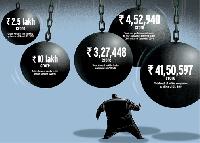
The Economic Survey 2016 and the Mid-Year Economic Analysis 2015 (both by the Ministry of Finance) have popularized two related concepts in recent years. First is the concept of balance sheet syndrome with Indian characteristics and the second, the twin balance sheet (TBS) problem. The two are highly related. Understanding the balance sheet syndrome will help us to understand the twin balance sheet problem.
Balance sheet syndrome with Indian characteristics
The term ‘balance sheet syndrome with Indian characteristics’ was mentioned in the Mid-Year Economic Analysis 2015, by the Ministry of Finance and was elaborated in Economic Survey 2015. Here, the balance sheet syndrome refers to the worsening profit scenario and mounting losses of private sector specifically corporate. High losses by the corporate discourages future investment and in this way, the economy suffers.
The balance sheet problem of rising debt and losses occurred in many other countries especially in advanced countries in recent years. But in India, unlike in Japan and in the US, the problem has some unique features and hence is a “balance sheet syndrome with Indian characteristics.” In Japan, there was a balance sheet problem after the real estate and equity boom of the late 1980s. similarly, in the US there was a balance sheet problem after the global financial crisis.
The economic survey elaborates three reasons to show why this syndrome is distinctively Indian.
First, India is not suffering from recession or stagnation (in Japan and in the US, there is recession).
Second, in India, there is no weak macro-economic demand. Rather, there is moderately strong demand (at least relative to supply) reflected in moderately high inflation and a moderately high current account deficit. On the other hand, in advanced countries like the US and Japan, demand is poor.
Third, perhaps even more distinctly, the Indian balance sheet problem has partly due to private sector investment in infrastructure via the so-called public private partnership (PPP) model. This was because the public sector was reluctant to actively intervene in infrastructure projects.
What are the reasons for balance sheet sundrome?
There are five reasons for the balance sheet syndrome.
Frist is weak profitability and high burden of debt for the private sector: Weak profitability and over-indebtedness discourages investment by corporate in India.
Second, stalled projects and inadequate bankruptcy procedures. Third, failed PPP models has contributed to losses of the private sector.
Fourth, many PSBs have financed several infrastructure projects and stalled infrastructure projects has resulted in large volume of stressed assets in banks.
Fifth, the PSBs are now not ready to give loans to the business sector fearing penal action for managers in the context of rising NPAs. It further stalls projects by the corporate.
What is painful about the balance sheet syndrome is that is discourages private investment. “The balance sheet syndrome with Indian characteristics” creates a web of difficult challenges that could hold back private investment. Private investment must remain the primary engine of long-run growth.
The survey observes that because of this balance sheet problem, increasing capital flows will not be converted into real investment in the private sector.
How to escape from the syndrome?
Public investment overall is necessary to escape from the syndrome. To revive growth, public investment, especially in the railways, will have an important role to play.
*********









